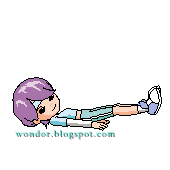Don't ignore it at all... this may lead to many further diseases and disabilities as well.
---------------------------------------------------------
Inhale deeply before each repetition of an exercise and exhale when performing each repetition. Exercises to strengthen your muscles.
A typical response to experiencing back pain is to take it easy - either staying in bed or at least stopping any activity that is at all strenuous. While this approach is understandable and may even be recommended in the short term, when done for more than a day or two it can actually undermine healing. Instead, active forms of exercise are almost always necessary to rehabilitate the spine and help alleviate back pain.
Practical Point -
For most back conditions, active exercise and stretching - not rest - is typically necessary to help reduce pain and encourage healing. To be effective, a patient’s back pain exercise program should be comprehensive, working the whole body even if it targets the back. A balanced workout should include a combination of stretching, strengthening, and low impact aerobic conditioning.
Stretching as part of a back pain exercise routine -
Almost everyone can benefit from stretching the soft tissues - the muscles, ligaments and tendons - in the back and around the spine. The spinal column and its contiguous muscles, ligaments and tendons are all designed to move, and reduced motion can accentuate back pain. Stretching different muscles and ligaments is essential for gaining and maintaining mobility and flexibility. Patients with chronic back pain may find it takes weeks or months of stretching to mobilize the spine and soft tissues, but will find that meaningful and sustained relief of low back pain typically follows the increase in motion.
The most important muscles to target are -
- Hamstrings, in the back of the leg, to aid correct posture while sitting and standing, and support the gluteus muscles in the buttocks and the hip flexors and minimize stress on the low back.
- Piriformis, which run from the back of the femur (thigh bone) to the sacrum (the base of the spine). When tight, this muscle can cause sciatica-like pain, and has been linked to sacroiliac joint dysfunction.
- Psoas Major which is attached to the front portion of the lower spine and can greatly limit low back mobility if tight, making it hard to stand for extended periods or kneel on both knees.
- Gluteus muscles of the buttocks which support hip flexibility as well as the pelvis.
Stretching should be done daily, perhaps several times a day, to ensure flexibility. See also Stretching for back pain relief.
Strengthening exercises to build muscle support -
Developing strong core muscles in the abdomen, lower back and gluteus is critical to decreasing the stress placed upon the lower back. Many different exercises can contribute to overall strengthening of these core muscles, and two types of exercise programs are often ecommended for back pain patients are:
- Dynamic lumbar stabilization. This back exercise is designed to help patients find their "neutral" spine, which is the position that allows the patient to feel the least discomfort. The back muscles are then exercised to teach the spine how to stay in this position and help the patient be aware of the position.
- McKenzie extension exercises. These back exercises focus on extending the spine to reduce the pressure on, and the pain generated from, a herniated or degenerating disc. Pain relief can be felt in both the back and the leg, and when the pain is very acute the exercises may be done several times a day.
- Both of these types of exercises are best learned working with a trained physical therapist, although with practice patients can do the exercises by themselves. See also Strengthening and back pain exercises.
Low impact aerobic exercise -
Engaging in a low-impact cardio exercise program will aid rehabilitation and maintain everyday functionality. While some back pain patients can engage in running and other types of cardio exercise, for many with serious back pain it is more realistic and comfortable to engage in low impact cardio conditioning that is easy on the joints and gentle on the back.
There are several types of aerobic exercise that are gentle on the back and, when done on a regular basis, highly effective in providing conditioning:
- Walking. In general, walking is very gentle on the back, and walking two to three miles three times per week is very helpful for patients.
- Biking or cross-training. Bicycling or using an elliptical cross-trainer are also effective ways to exercise without putting stress on the back.
- Water therapy. Exercising in the water provides weightless conditioning, which minimizes stress on the back and joints throughout the body.
Most physicians recommend at least 20 to 30 minutes of cardio exercise every other day to keep in shape. Patients could alternate days of cardio and strength conditioning to get a daily dose of exercise and allow muscle groups time to rest. See also Low impact aerobic exercise.
[By Peter F. Ullrich, Jr., MD ]
-----------------------------------------------------------
Don't panic, just do the following exercise for min 10 minutes every morning and shoot off the back pain.








No comments:
Post a Comment